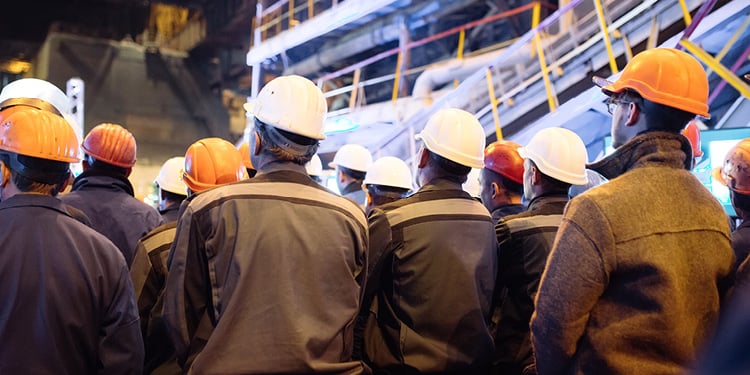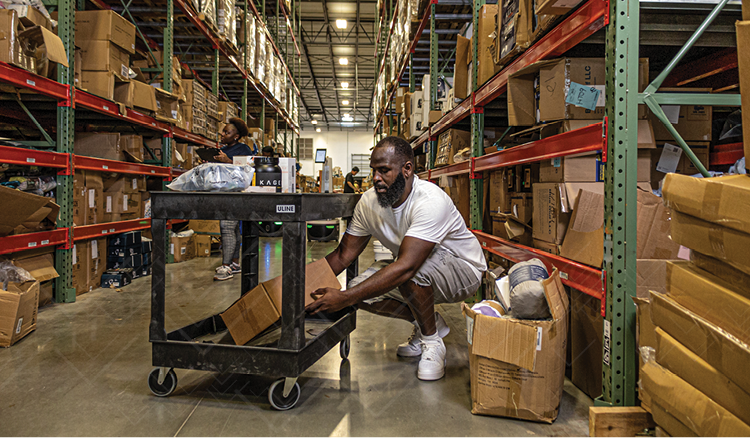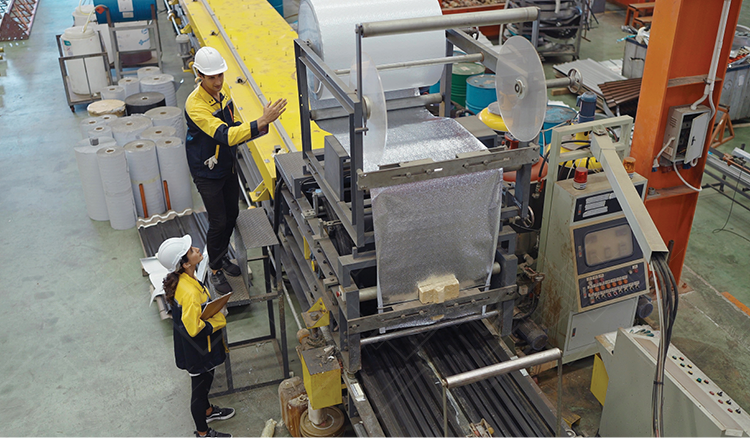The Complete Cycle and Impact of an Automotive Strike
Every industry and business has their ups and downs. Currently, the automotive industry is experiencing this but in a more unexpected way. A series of strikes has sent ripples across the vast network, dragging suppliers, many unprepared, into the depth of a downturn.
This article aims to dissect the stages of a full cycle so that manufacturers can understand where they are at, the impact(s) on their business and what they can do about it. We specifically call out what this means for the automotive industry using the strike as an example of what has already happened and what has yet to come.

This graphic will serve as a roadmap for the conversation explaining both the reduction and the rebound of the downturn. We will also discuss the operational and financial impacts for both operations leaders in manufacturing as well as in the automotive industry.
(1) Normal Operations - Business as Usual

In Operations: Generally, in most manufacturing operations supply and demand ebbs and flows. Orders come in at different rates, the mix of your product may shift, and material availability or supply chain issues throw production plans off kilter. With all of these changes, most operations plan for the average and try to align their workforce to that plan. What actually happens on the workforce side is equally messy. There are call-offs, skill gaps across work areas, people unexpectedly jump ship for another opportunity, or the labor you need is simply not there. These are normal everyday problems that operations leaders face in running their plant. Trying to balance workload and workforce is important because of the impact if you have too much or too little.
In Automotive: The Automotive industry is no different. It is subject to the same challenges and, at times, can be more difficult to overcome. The sprint to stop reaction of releases introduces an incremental challenge on how orders filter throughout the supply chain, and material availability and part shortages amplify an already volatile planning process as highlighted in this article by Forbes. Workforce challenges mirror most operations but with increased variation in the production plan the stops and starts puts incremental strain on the full-time employees. Hours may be shortened one week and overtime is forced the next week. Mandatory OT is an accelerant for attrition and a deterrent for new hires. If an operation cannot find the labor needed, forced overtime becomes a semi-permanent crutch. Flexibility has become an increasingly important aspect in the automotive industry and one that companies will need to figure out a solution for.
Financial and Operational Impact: Balancing orders with the material, equipment, and labor resources are a part of running any manufacturing operation and a challenge operations leaders have faced for decades. This daily imbalance, over a period of time or across work areas, will have a negative impact on the financials and performance of your business. Too many orders and not enough equipment/labor capacity will force you to decide between shipping orders late, extending lead times, or attempting to solve it with overtime even though it erodes your margins. The inverse is also true, having too much labor and not enough orders will decimate your productivity numbers, create absorption issues on the P&L, or aggravate your workforce with reduced hours.
(2) Demand Begins to Drop - Initial Strike Actions

In Operations: There are countless examples of how some macroeconomic factor reduces demand either in a specific industry or across an entire sector, region, or globally. You can see this in the early onset of a recession or even during Q1 of 2020 as Covid began to unfold. Something, typically outside of what a business controls, starts to decrease volume. At first this may even look like a typical drop in the normal ebb and flow in Stage 1. As demand continues to decrease there is uncertainty around what this forward view of volume looks like. A business is unsure how long this will last or how deep the drop will be. Because of this uncertainty, businesses are generally optimistic and chose to weather the storm as opposed to reducing workforce.
In Automotive: The automotive industry is impacted in the same way during a recession or Covid, but the recent strike shows a more significant example of this initial pullback. During this period the Stand Up Strike started. Negotiating tactics aside, this was intended to disrupt work and put pressure on the manufacturers, but not for an extended period of time. Shorter duration, focused targeting, continuous action, and minimized disruption for both the company and its members. Changing the location of these early strikes served as a way to impact not just that operation but the upstream and downstream operations that it touched. Hitting without notice and then announcing impacted plants provided insights to understand how long lasting and far reaching this part of the storm would be.
Financial and Operational Impact: Here is where the financial and operational impact starts to show itself. The gap between orders and labor starts to widen. In most macroeconomic situations there is a volume decrease with excess labor. In the instance of the strike, orders continue to pile up but the labor is not there and product is not shipped. Delivery dates are missed, equipment sits idle, and fixed costs continue to stack up. That equipment/plant capacity is lost forever and you cannot get that time back. This begins to trickle throughout the supply chain. Since orders are not being made, material is not pulled which stops upstream operations. Material is not shipped so that starves downstream operations. The labor stoppage creates a volume drop across the suppliers and customers relative to the size of that stoppage. While the striking site might take action, those impacted indirectly typically weather that storm losing productivity and margins while waiting (hoping) that things will return to normal quickly.
(3) Deeper Demand Drop - Larger Strikes are Initiated

In Operations: At this stage a business can no longer ignore the impact that the imbalance in orders that labor is having on the company. The financial repercussions of prolonged inaction are becoming apparent. While the future remains uncertain, measures such as budget cuts and layoffs are being initiated to help right-size the business. Typically a business will make adjustments to the current volume levels or retain a little bit of excess labor to serve as a buffer. Depending on how quick the company takes action, or how deep this drop goes a business may struggle with several waves of cuts until the bottom is hit.
In Automotive: Although the strike is self-inflicted, this stage looks and acts very similar. As the strike escalated, the size of the strikes increased as did the layoffs across the industry. There was no warning of location or timing given which reduced the planning window. Each OEM was hit differently, and as tentative agreements were reached that attention was shifted to those still in negotiations. The impact on the business extends beyond the hourly workforce and the company looks to salvage what it can to prepare itself for the rest of this phase.
Financial and Operational Impact: In this phase, all operational and financial metrics are impacted in a significant way. Those stage 2 ripples we talked about across the supply chain have turned into waves. The P&L reflects a retrospective impact of this imbalance, and until the bottom is reached and identified, any forward view of the future impact remains, at best, only speculative. The business and business leaders are in survival mode trying to extend the runway and protect the impact to stakeholders. Speed in decision making and action can have a large impact on the business and how you handle that relative to your competition can put you in a better position to survive.
(4) Bottoming Out and a Cautious Return

In Operations: It’s hard to know that you have reached the bottom until the drop flattens out for a while. In many ways the early part of this stage operates very similarly to normal operations in stage 1, just at a severely reduced volume level. Externally, you will still be impacted by the decisions made by your suppliers and your customers and how quick they were able to react and stabilize their operations. Internally within your operations there are still the day to day imbalances that you will have to deal with. As the recession or downturn eases, demand will start to slowly increase. Understandably, leaders are hesitant to react because they are unsure if this new volume is stable and they are still in survival mode looking to protect the business.
In Automotive: This is where the automotive industry is as this article is being written. Although for very different reasons, the environment acts the same. The Big Three are in different stages of ratifying a tentative agreement with Ford, Stellantis, and GM. Companies and their respective supply chains are beginning to put together plans on how to start back up and ramp their equipment, operations, and workforce. This plan is still extremely volatile and looks different for every operation. Orders, priorities, and releases will be a function of inventory levels, and the OEM ramp. Each supplier will have a different portfolio of products, programs and platforms they support. The further down the supply chain the more uncertainty there is. Some operations will be ramping from 0 to 100 in days, while others might take weeks because of a different mix and their respective signals. Material availability outside of what you have within your four walls is uncertain and will take some time for the entire supply base to put together plans and put those plans in action.
Financial and Operational Impact: Impact in this stage can be generalized into two main buckets. First, there is the cost of the volatility. In normal operating circumstances it takes extreme coordination to try and optimize cost, delivery, quality, inventory, cash, and productivity. The bullwhip effect of fluctuating production demands across multiple sites and tiers takes a substantial amount of time and effort from the second the green like is given until things are stable again. During this period, there are rampant starts and stops, adhering to a production schedule proves to be challenging, and instances of idle hands or forced overtime are widespread across this startup phase.The second bucket is the opportunity cost. Knowing that this ramp is chaotic, many businesses will wait for those initial iterations to settle before really putting forth any effort at recovery. Although this is a protective stance to mitigate further cost loss and an effort to stabilize their operations quicker, it does little to help the overall system normalize. Here is where that opportunity cost comes in. A customer remembers those that help them get back on track quicker. When you can respond better, faster, and in lock step with their changing needs, you become an even more valuable resource for them. Figuring out how to be flexible without driving more cost into your operations is the dilemma business leaders grapple with while determining how to plan and support their teams.
(5) Continued ramping and getting back to business as usual

In Operations: In this stage, there is enough evidence that things are rebounding and that the company is climbing out of the hole that you have been suffering through for a while. Hesitation on during the early orders have subsided and you are ready to scale. Your equipment has not changed, the supply of material has resumed, but now the problem is with labor. The people that you laid off, may or may not still be there. They may have jumped at the first opportunity they had with another company. The skills you need may not be available or come at a cost more than you budgeted for. As you look for new people to bring into your organization, not only is it hard to attract people, you have to consider are they the right ones? The process to find, attract, filter, and test is a lengthy process. You are competing with everyone else in this same space at the same time. So what would normally take 4 weeks may take 8 or 12 weeks before you can find someone who can do some of what you need at a higher cost. In this timeframe, you are missing the rebound.
In Automotive: As the supply base works through those early weeks of the ramp this will begin to stabilize. There will be more visibility to hitting those ramp milestones and it will be very clear who is and who is not performing. Automotive suppliers will be impacted by the same challenges as mentioned above. Even if all of your organized labor comes back, there is significant risk that other areas do not have. A portion of the workforce will decide to move on, they may have changed industries, they may have prioritized other parts of their lives and your company will need to figure that out. Even if your operations are not impacted, your supply base is and may have different considerations and situations that they are in. Your supply chain will need new solutions to solve this issue. Bringing new people in will take a long time and there will be a learning curve - all of which impacts your ability to hit deadlines and capture that rebound.
Financial and Operational Impact: This return of volume is what everyone has been waiting for. Your ability to capture it will be a function of how quick you can react and how fast you can scale. Bringing labor capacity back is not that easy, especially as you compete with others at the same time. This drives wage inflation and job hopping as the workforce capitalizes on that need. If you cannot scale your labor, not only do you risk capturing that volume, you risk losing it to someone who can deliver on those promises. This is a very competitive space where unless you have exclusive agreements or a niche process or product that volume is up for grabs. It typically goes to the supplier that can help their business capture the market share they are after. Driving both flexibility and agility into your operations is the best way to capture as much of the rebound while also positioning your business for the future.
A Path Forward
If you are an operations leader in the automotive space, you are currently living through this chaos. The decisions your operations team makes will have both short-term and long-term impacts on your business. Similarly, if you are an operations leader in manufacturing, logistics, or warehousing, you are feeling the ripple effects as the US economy teeters on the edge of a recession, with many sectors behaving as if we are already experiencing it.
Going through a downturn is challenging, but the financial and operational impact is a function of how quick you take action on it. The double-edge sword of waiting too long on the downturn and being too slow to react on the rebound leaves a lot of opportunity for your business if you are prepared. Veryable’s on-demand labor platform is built exclusively for manufacturing, logistics, and warehousing to solve for these gaps between demand and labor.
The automotive industry is our fastest growing segment as more companies realize it is impossible to optimize their business with a purely fixed labor model. We are an operational platform built for operational leaders to give them the tools and resources to be successful. We operate in union and non-union environments across the entire supply chain. To learn more about our concept check out case studies, customer testimonials, and automotive blogs at our Automotive Industry page.
Previous Posts
How Policy Constraints, Not Just Production Bottlenecks, Threaten Your Bottom Line
The Future of Manufacturing and Logistics
Create a free business profile today to explore our platform.






